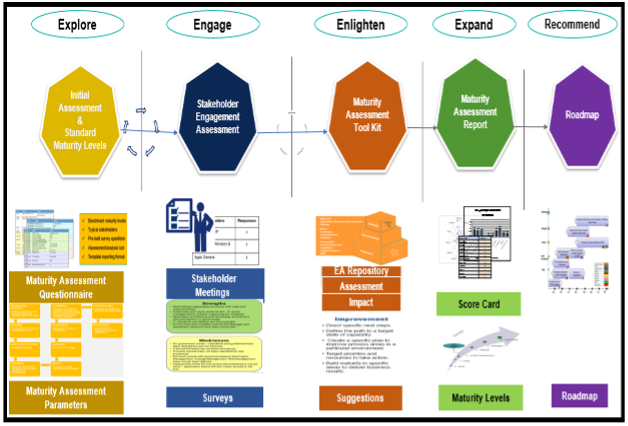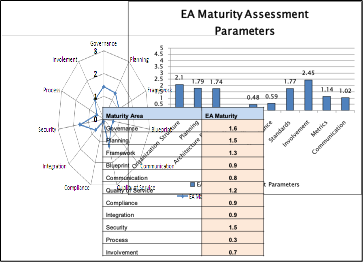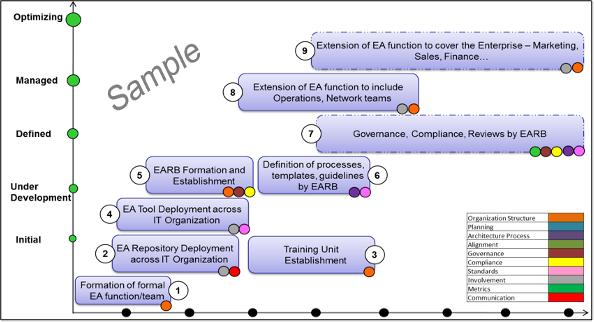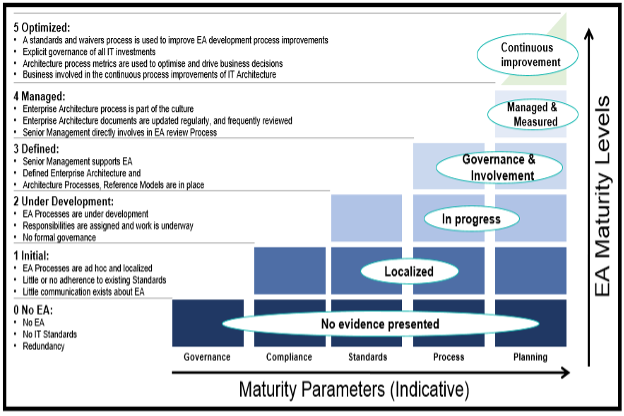
By Dr. Gopala Krishna Behara
Enterprise Architecture (EA) is the blueprint of the enterprise. But that EA definition is not a one-time event, nor limited to specific projects or business units. EA is an ongoing, iterative process that provides:
- Common vision of the future shared by business and information
- Guidance in the selection, creation and implementation of solutions driven by business requirements
- Support for the various Enterprise business lines through improved information sharing – provides plan for the integration of information and services at the design level across business lines
- Means to control growing complexities of technology by setting enterprise-wide, leverage-able, standards for information technology
- Consistent process for creating new systems and migrating old systems
- Defines an approach for the evaluation, consideration, and assimilation of new and emerging technology innovations to meet business requirements
MATURITY MODEL
“A Maturity Model is a structured collection of elements that describe certain aspects of maturity in an organization.”
“Enterprise Architecture Maturity (EAM) indicates the maturity of the EA discipline in an organization.”
As the EA matures, the predictability, process controls and effectiveness also increase. Development of EA is critical because it provides the rules and definition necessary for the integration of information and services at the operation level across the enterprise’s boundaries. EA includes business tasks and activities and representations and supportive technology components.
The progress of EAM benefits an organization with the following:
- Reduced software and data redundancy
- Enhanced enterprise information sharing
- Reduced information systems / IT complexity
- Greater reliability at implementations & updates
- Reduced dependency on key resources
- Improved accuracy in scheduling software development / implementation
- More accurate forecasting of development and support costs
- More efficient deployment of technology solutions
- Greater ability to set realistic goals
- Improved alignment of IT solutions with business strategy
- Increased traceability
This article describes the steps toward assessing the maturity of an enterprise in an Architecture Stream.
MATURITY ASSESSMENT
Today, many organizations need to improve their IT-related development processes to successfully manage change, but don’t know how. These organizations typically either spend very little on process improvement, because they are unsure how best to proceed; or spend a lot, on several parallel and unfocused efforts.
Assessment is the evaluation of the EA practice against the reference model. It determines the level at which the organization currently stands. It indicates the organization’s maturity in the area concerned, and the practices on which the organization needs to focus to see the greatest improvement and the highest return on investment.
Maturity Assessment allows the stakeholders to establish the following:
- How the organization performs against the original business mandate for EA and investment in this function
- How EA does as a function with respect to industry best practices
- How the organization is doing in relation to other organizations that have adopted EA
- How quality metrics associated with architecture process are captured
- How capital planning and investments are adjusted and frequent review of business and IT drivers
- Explicit governance of all IT investments
- Mergers & acquisitions are guided and governed by EA
- compliance to defined standards
- Better management of regulatory controls and compliance
- What are the gaps
- Where should organizations focus for future attention
Development of the EA is an ongoing process and cannot be delivered overnight. An organization must patiently work to nurture and improve upon its EA program until architectural processes and standards become second nature and the architecture framework and the architecture blueprint become self-renewing.
EA MATURITY ASSESSMENT FRAMEWORK
Maturity assessment is a standard business tool to understand the maturity level of the organization.
An EAM Assessment Framework comprises a maturity model with different maturity levels and a set of elements, which are to be assessed, methodology and a toolkit for assessment (questionnaires, tools, etc.). The outcome is a detailed assessment report, which describes the maturity of the Organization, as well as the maturity against each of the architectural elements.
The EAM Model is used to conduct the maturity assessment. The model provides the framework that represents the key components of a productive enterprise architecture process. The goal is to enhance the overall success of EA by identifying weak areas and providing a defined evolutionary path to improving the overall architecture process.
The 5 key stages and components of the EAM Assessment Framework are:
- Explore
- Engage
- Enlighten
- Expand
- Recommend
The following diagram depicts the EA Maturity Assessment Framework:

Fig 1: EAM Assessment Framework
Explore: In this step the assessment criteria are finalized, using industry best practices and standards. The architecture elements to be evaluated are decided upon and weights are assigned to the elements depending on importance. For the present assessment, we assigned equal weights to all the identified architecture elements that were evaluated. Based on industry standards and author consulting experience the following high level architecture elements are identified and are to be assessed as part of the EAM assessment methodology.
| Architecture Element | Description |
| Organization Structure
|
This element covers the organization structure that exists for the EA program – roles and responsibilities of team members and their skill sets with respect to Enterprise Architecture |
| Planning
|
Planning ensures the program is managed to assure the goals for implementation are realistic and achievable and the program is kept within scope. It also indicates whether a clear vision exists for business architecture development within the enterprise |
| Architecture Process
|
This element indicates whether there is any process in place for architecture development and how effectively is it followed. |
| Alignment
|
This element indicates whether the activities of the IT/Architecture teams are aligned with the organization’s business goals and objectives. It indicates whether IT senior management is actively involved with business teams in the decision making process. |
| Governance
|
Architecture governance is the practice and orientation by which enterprise architectures and other architectures are managed and controlled at an enterprise-wide level. |
| Compliance | Architecture Compliance review is a scrutiny of the compliance of a specific project against established architectural criteria and business objectives. |
| Standards
|
It covers the processes, guidelines, templates and forms used by those involved in the process of architecture development. |
| Involvement
|
Involvement must be part of an EA Program. Without the support of managers and employees who are expected to utilize and follow the defined process, the program is sure to fail. Involvement addresses the ability of the various entities (internal or external to the organization) to coordinate their efforts to the greatest benefit of the organization. |
| Metrics
|
This element indicates EA maturity in terms of measurement and monitoring of EA activities and efforts. It indicates if the results of EA activities are being captured and measured and the benefits of the EA program have been quantified |
| Architecture Communication
|
Communication is the element that ensures standards and processes are established and readily available to team members for reference and use. As an organization changes and programs evolve the continued communication ensures the EA program remains vital and operates optimally |
Engage: To assess the maturity, a survey methodology was used for gaining access to different teams and departments of the enterprise. Questions were prepared keeping goals and objectives of the EA program in mind. A different set of questionnaires were prepared for key different stakeholders of the organization to respond.
Enlighten: The questionnaires were circulated to different stakeholders and their responses were collected. The responses were fed into the maturity assessment tool. The maturity levels against each response and the corresponding weights were already built into the tool. The tool computed maturity scores of each question, and subsequently, each element, based on the responses.
In this step, the responses and scores are studied in detail. The information collected is validated and observations against each architecture element are documented. By this stage one gets a fair idea of the maturity level individual architecture elements as well as that of the enterprise.
This results in an Enterprise Architecture Maturity Score Card.
The EAM Scorecard describes the maturity scores with respect to each of the architecture elements and their maturity level on basis of the maturity assessment exercise, which was conducted across the organization. The following diagram depicts the sample Maturity Score card:

Figure 2 – EA Maturity Score Card Conclusion
Expand: The assessment concludes with a formal report on the assessment findings. The maturity level of each parameter and the enterprise maturity level were prepared. The report also includes recommendations or immediate next steps to be undertaken for each parameter. The report should ensure that both the information and data presented meets the stakeholders’ needs.
Recommend: EAM Roadmap is a plan for organization to improve their EA maturity level by implementing suggested projects/programs over a defined period. The purpose of the EA roadmap is to guide organization and employers on sequence and priorities required to advance and mature EA practices and the profession. The following diagram depicts the sample EA Maturity Roadmap:

Figure 3 – EA Maturity Roadmap
ENTERPRISE MATURITY LEVELS
The diagram below depicts the EAM Model and its various stages. The model follows the path of an organization as enterprise architecture program matures and sets benchmarks to measure the performance and path that is a natural progression in the development of EA.
In the following sections, each of the levels of the EAM Model is defined. Each level contains statements that are indicative of an EA Program at that level.

Figure 4 – Enterprise Maturity Levels
| Level | Description |
| Level 0:
No EA
|
There is no documented architectural framework in place at this level of maturity. While solutions are developed and implemented, this is done with no recognized standards or base practices. |
| Level 1:
Initial
|
The base architecture framework and standards have been defined and are typically performed informally. Organizations with an Enterprise Architecture framework at this level are still dependent on the knowledge of individual contributors. |
| Level 2:
Under Development
|
The vision, principles, base architecture and standards have been identified and are being tracked and verified. At this point in the maturity program processes are repeatable and reusable templates are starting to be developed. |
| Level 3: Defined
|
The enterprise architecture framework is well defined using approved standard and/or customized versions of the templates. Processes are documented across the organization. Performance metrics are being tracked and monitored in relationship to other general practices and process areas.
|
| Level 4: Managed
|
At this point performance metrics are collected, analyzed and acted upon. The metrics are used to predict performance and provide better understanding of the processes and capabilities.
|
| Level 5:
Optimizing
|
The processes are mature. Targets have been set for effectiveness and efficiency based on business and technical goals. There are ongoing refinements and improvements based on the understanding of the impact changes have to these processes. |
CONCLUSION
Maturity within the architecture framework will vary across the business architecture, business processes, technology architecture, as well as the architecture blueprint. This is an ever-evolving process of enterprise that leads to an efficient, effective responsive development and support organization.
The architecture blueprint is not a document that we produce once, store on the shelf and reference on occasion. It is a plan and a methodology and allows for better analysis for future decisions.
The most important elements to be considered in the architecture assessment/objectives are:
- Enterprise Standards compliance
- EA principles compliance
- Business Architecture Assessment
- Operational standards compliance
- Functional assessment with respect to objectives & goals
- Reuse of existing application/technology/infra components
- Leveraging existing/applicable competencies and skills
- Non-functional requirements compliance
Acknowledgments
The author would like to thank Santosh Shinde of BTIS, Enterprise Architecture division of HCL Technologies Ltd for giving the required time and support in many ways in bringing this article as part of Architecture Practice efforts.
About Author
Dr. Gopala Krishna Behara is an Enterprise Architect in the BTIS Enterprise Architecture division of HCL Technologies Ltd. He has a total of 27 years of IT experience. Reached at gopalakrishna.behara@gmail.com.
Disclaimer
The views expressed in this article/presentation are that of the authors and HCL does not subscribe to the substance, veracity, or truthfulness of the said opinion.
